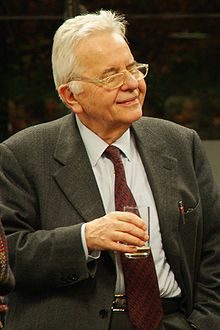Nicola Cabibbo
Nicola Cabibbo (born April 10, 1935 in Rome ; † August 16, 2010 there ) was an Italian physicist .
Life
Cabibbo was the son of a Sicilian lawyer. In 1958 he completed his physics studies at the University of La Sapienza in Rome with Bruno Touschek . One of his teachers in Rome was Edoardo Amaldi . He then worked as a researcher at the National Institute for Nuclear Physics ( INFN ) (1958–62), where Touschek was just building the first electron-positron collider in Frascati. Cabibbo wrote a pioneering paper there with Raoul Gatto on the physics of these new accelerators. From 1962 to 1963 and 1964 to 1966 he was at CERN interrupted by a stay in 1963/64 at the Lawrence Berkeley National Laboratory . From 1965 to 1966 he was professor of theoretical physics at the University of L'Aquila , 1966–82 at his home university in Rome, 1982 to 2000 at the University of Tor Vergata in Rome and since 2000 again at La Sapienza. Cabibbo was President of the INFN from 1983 to 1992 (during which time the Gran Sasso Underground Laboratory was founded ), from 1993 to 1999 Chairman of the Italian Authority for New Technology, Energy and Environment (ENEA) , and from 1993 also President of the Pontifical Academy of Sciences . In 2004 he was visiting professor at CERN. From 2006 until his death he was chairman of the scientific council of the International Center for Theoretical Physics .
In his special field of high-energy physics , the weak interaction , the Cabibbo angle postulated by him in 1963 was named after him, with which one can explain transitions between the quarks of the first and second family. First he introduced the angle for the uniform description of weak decays that preserve and injure strangeness , later he transferred this to the quark model, whereby initially only the three quarks u , d and s were known. In the GIM mechanism , this was expanded to include the charm quark (two quark families). By Makoto Kobayashi and Toshihide Maskawa theory was extended to three quark families (see CKM matrix ). Cabibbo's interest later switched to the application of supercomputers in physics. Together with Giorgio Parisi and others, he developed parallel computers in the APE project in the early 1980s (continued in the 2000s in APEmille and APEnext projects), which were used to simulate quantum chromodynamics in lattice scale theories . He also used lattice theory to calculate CKM parameters from observables of hadrons .
Cabibbo was married and had one child.
He died on August 16, 2010 in Rome at the end of a long illness.
Memberships
- since 1981: American Academy of Arts and Sciences
- since 1982: National Academy of Sciences
- since 1987: Accademia Nazionale dei Lincei
- since 1995: President of the Fondazione "Edoardo Amaldi"
- 2008: Foreign member of the Russian Academy of Sciences
Prices
- 1979: “National Prize of the President of the Republic” from the Accademia Nazionale dei Lincei
- 1989: Sakurai Prize of the American Physical Society
- 1989: Special Prize for Scientific Research from the Italian Prime Minister
- 1991: High Energy and Particle Physics Prize of the EPS
- 1993: Grand Cross of the Order of Merit of the Italian Republic
- 1998: Benemerito della Cultura e della Scienza
- 2002: Matteucci Medal from the Italian Academy of Sciences
- 2010: Dirac Medal
- 2011: Benjamin Franklin Medal (posthumous)
literature
- Luciano Maiani: Obituary: Nicola Cabibbo (1935-2010). Obituary in: Nature . 467/2010. Nature Publishing Group, ISSN 0028-0836 , p. 284
Web links
- Literature by and about Nicola Cabibbo in the catalog of the German National Library
- MGK Menon, Werner Arber: Nicola Cabibbo. Pontifical Academy of Sciences (English).
- Guido Altarelli, Luciano Maiani, Roberto Petronzi: Obituary. In: CERN Courier. October 26, 2010 (English).
- In memoriam - Nicola Cabibbo. ICTP, September 1, 2010(English).
Individual evidence
- ↑ Unitary Symmetry and Leptonic Decays . In: Physical Review Letters . Volume 10, 1963, pp. 531-533
- ^ E 'morto il fisico Cabibbo. In: La Stampa. Archived from the original on August 18, 2010 (Italian).
- ^ Foreign members of the Russian Academy of Sciences since 1724. Nicola Cabibbo. Russian Academy of Sciences, accessed September 2, 2015 (Russian).
| personal data | |
|---|---|
| SURNAME | Cabibbo, Nicola |
| BRIEF DESCRIPTION | Italian physicist |
| DATE OF BIRTH | April 10, 1935 |
| PLACE OF BIRTH | Rome |
| DATE OF DEATH | August 16, 2010 |
| Place of death | Rome |

